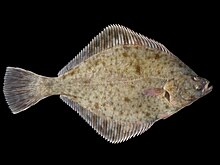Platichthys flesus
| European flounder | |
|---|---|
 |
|
 |
|
| Scientific classification | |
| Kingdom: | Animalia |
| Phylum: | Chordata |
| Class: | Actinopterygii |
| Order: | Pleuronectiformes |
| Family: | Pleuronectidae |
| Genus: | Platichthys |
| Species: | P. flesus |
| Binomial name | |
|
Platichthys flesus (Linnaeus, 1758) |
|
| Synonyms | |
|
|
The European flounder (Platichthys flesus) is a flatfish of European coastal waters from the White Sea in the north to the Mediterranean and the Black Sea in the south. It has been introduced into the United States and Canada accidentally through transport in ballast water. It is caught and used for human consumption.
The European flounder is oval in shape and is usually right-eyed. It normally grows about 30 cm in length, although lengths of up to 60 cm have been recorded. The upper surface is usually dull brown or olive in colour with reddish spots and brown blotches and this fish can change colour to suit its background, providing an effective camouflage. The underside is pearly-white, giving the fish one of its common names, the white fluke. The lateral line features rows of small tubercles, as do the bases of the dorsal and anal fins.
The European flounder is a flatfish with an oval-shaped body with a width about half its length. The maximum recorded length is 60 centimetres (24 in) and the maximum recorded weight 14 kilograms (31 lb). However, a more usual mature length is about 50 centimetres (20 in).
The fish is flattened laterally and swims and rests on one side. During development, its eyes usually migrate to the right side of the fish and what appears to be its upper surface is in reality its right side. In about thirty percent of individuals, its eyes move to the left and the left side becomes uppermost. The fish has a small mouth at the end of its bluntly pointed snout. The upper surface is fawn, olive green or pale brown with spots and larger patches of darker brown and some irregular reddish spots. The under surface is opaque pearly-white giving the fish its common name of "white fluke". The lateral line is nearly straight and runs along the middle of the upper surface, curving round the short pectoral fins. The dorsal fin runs from the base of the head to beside the caudal peduncle. It has no dorsal spines but has between 53 and 62 soft rays. The anal fin also runs the length of the body and has no spines and 37 to 46 soft rays. The skin is rough, with prickly tubercles at the base of the dorsal and anal fins, and there are large scales beside the lateral line. The caudal peduncle is about half the length of the tail and the caudal fin has a squared-off end.
...
Wikipedia

